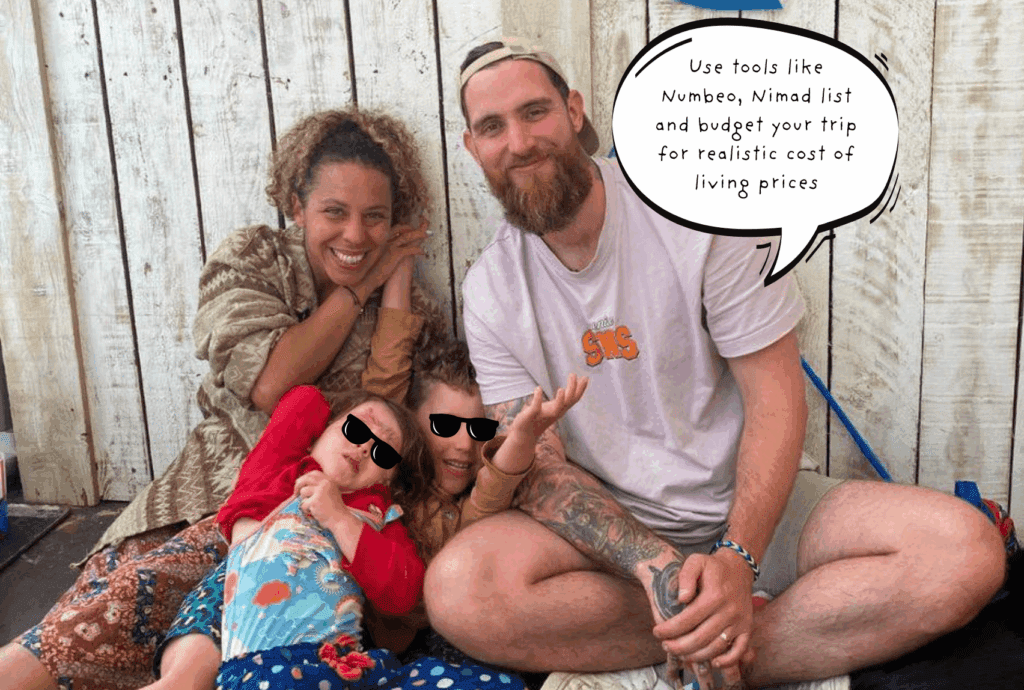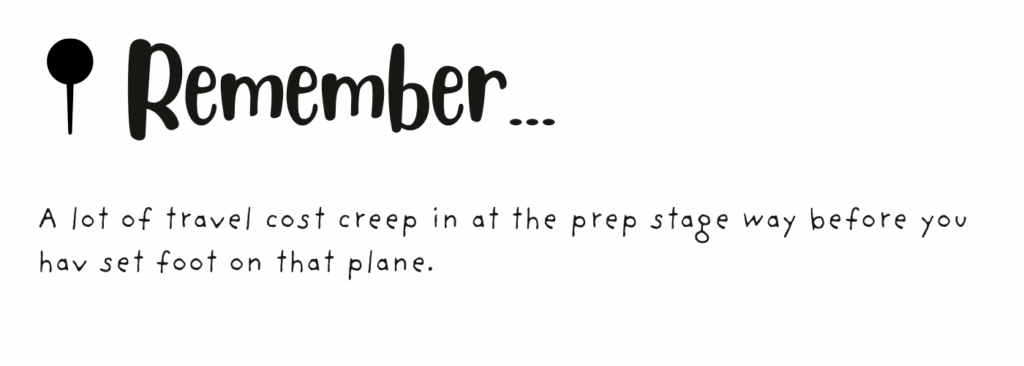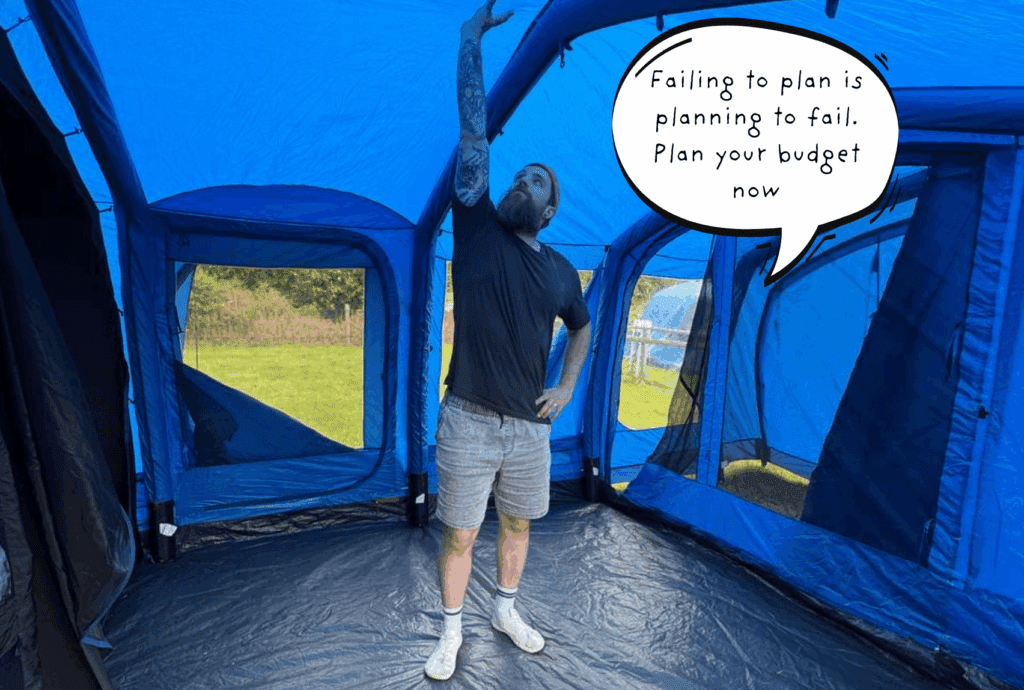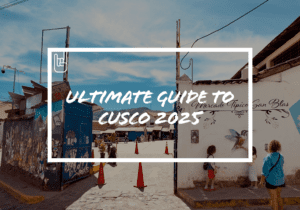What’s a “Good” Travel Budget? (And How to Know If Yours Is Realistic)
Wondering what a realistic travel budget looks like for long-term trips? Whether you’re backpacking solo, travelling as a couple, or budgeting for a family of four, getting your numbers right before you go is essential.
If you’ve ever typed “How much does it cost to travel for a year?” into Google and instantly regretted it, you’re not alone. The answers swing wildly from “I lived on £5/day in Bali” to “We spent £70,000 chasing the sun for 12 months”.
Here’s the truth: a “good” travel budget isn’t a magic number, it’s a number that actually works for you. One that aligns with your pace, priorities, family size (if applicable), and the real cost of living in the places you’re heading.
We’ve spent months building our own long-term travel budget, including research deep-dives, test runs, and spreadsheets full of what we thought we’d spend versus what actually adds up.
But I’ll let you into a secret, it’s no way near enough of what people usually say they have and tbh most would say “Lets keep saving and wait” and it would just never happen.
This post breaks down budgeting for travel in a way that’s practical, not preachy:
What different types of travellers typically spend
How to pressure-test if your number is realistic
The common costs most people forget (and later regret)
How to trial your budget before you ever leave home
Because if your budget isn’t grounded in reality, it doesn’t matter how many flight deals you find or backpacks you squeeze your life into. Let’s build one that holds up and stretches without snapping.
We’re building this while prepping for a year on the road with two kids. If you want to support the journey even just a little, here’s how.
Travel Budget Ranges by Style

Here’s a budget snapshot based on what full-time families, backpackers, and digital nomads actually report, especially in regions like South America, Southeast Asia, and Central America.
| Travel Style | Solo Traveller | Couple | Family of 4
|
|---|---|---|---|
Budget:
| £800–£1,200 | £1,400–£1,800 | £1,800–£2,800/month |
Mid-Range:
| £1,500–£2,000 | £2,000–£2,800 | £3,000–£4,000/month |
| Flexi/Hybrid: | £2,200–£3,000 | £3,200–£4,200 | £4,200–£5,500+/month |
These numbers shift depending on your pace of travel, visa length, destination cost-of-living, and non-negotiables (remote school tools, workspace needs, health coverage, etc.
Here’s the kicker: faster travel often = higher costs. Flights, transitions, and short-term rentals eat into your budget fast. Slower travel (1–3 months per stop) gives you time to negotiate rent, reduce transport, and settle into lower-cost routines.
For families, variables like food preferences (self-cater vs eat out), digital tools (VPNs, subscriptions), and healthcare access make a real impact. That’s why your “good” budget needs to reflect your style, not someone else’s.
Pro tip: Use tools like Numbeo or Nomad List to compare cost of living by region, and then cross-check it against your actual comfort zone.
We have a great cost break down of South America here
Is My Travel Budget Realistic? (Use This Checklist)
It’s easy to set a number and hope for the best. But here’s a more useful question: Can this budget survive real life, not just a spreadsheet?
Use this checklist to pressure-test your plan before you commit:
1. Does it include one-off, pre-trip costs?
A lot of travel budgets focus only on monthly spending. But what about:
Travel insurance (paid annually or upfront)
New backpacks, tech, adapters, or shoes
Vaccinations, dental, and one last GP visit
Visas and admin fees (and yes, passport renewals count.
2. Are you budgeting for where you’re going?
Cost of living in Ecuador ≠ cost of living in Italy. Use Numbeo, BudgetYourTrip, or Travelpayouts’ tools to build a location-based range, not a flat number.
3. Does it match your travel style?
Are you a slow-mad family staying a month per city? Or planning to country-hop every week? The faster you go, the more you’ll spend on transport and short-term stays.

4. Do you have a buffer?
Even if you’re budgeting carefully, things happen. SIM card headaches. Last-minute flights. A week of everyone getting sick and ordering takeout. Build in a 10–15% flex fund per month.
5. Have you tested living on it?
If you’re aiming for £2,500/month abroad, try living on that at home (excluding rent). If you can’t make it work now, you might struggle later.
Still unsure? Cross-check with our Ecuador cost of living breakdown or the full one-year budget here.
The Costs Most People Forget
Even the most detailed travel budgets can fall apart when real life kicks in. And it’s rarely because of flights or hotels, it’s the stuff no one mentions in those “How We Travelled the World for £12” YouTube videos.
Here’s what sneaks up on most people:
1. Travel Insurance (That Actually Covers You)
It’s not just “nice to have.” Proper travel insurance, especially for families or long-term trips, can run into hundreds of pounds per year. And cheaper policies? Often full of exclusions, you don’t notice until you really need it.
2. Tech Repairs, Storage & Backup Tools
That one charger you forgot. Your kid spills water on your laptop. Suddenly you’re at a mall in Mexico City paying £90 for a replacement. Don’t forget:
External drives
Cloud storage subscriptions
VPNs
SIM-unlocked phone swaps
3. Kid-Related Extras (aka “Snack Budget”)
From sticker books and rainy-day apps to comfort snacks and museum entrance fees, small kid costs add up. Especially when you’re parenting without the usual routines or support systems.
4. Currency Exchange & Banking Fees
ATM fees. FX fees. Transfer charges. Unless you’re using no-fee travel cards (like Wise or Starling), this can drain you slowly. Even £3–£5 per withdrawal adds up over months.
5. Visas, Entry Requirements & Proof of Funds
Especially in South America, Asia, and parts of Europe, you may need:
Onward tickets
Bank balance proofs
Entry/exit stamps with fixed dates
Each one = time, money, and admin.
👉 Tip: Keep a buffer fund just for surprises like these. Not if when.
How to Test Your Budget Before You Leave

Before you hand in your notice or book those one-way flights, there’s one more step we recommend: test your budget like it’s real life. Because no spreadsheet survives contact with actual travel.
Here are three ways to pressure-test your numbers:
1. Live on Your Travel Budget Now
If your goal is to spend £2,500/month on the road, try living on that at home for a full month, minus your rent or mortgage (assuming that cost drops when you leave).
Use it to cover:
- Groceries
- Transport
- Eating out
- Family outings
- Subscriptions and digital tools
Track every expense. If it’s tight now, it’ll be tighter when things go sideways abroad.
2. Simulate Your Route with Real Data
Pick 2–3 destinations you’re planning to visit and mock up a sample month for each using:
NomadList
Include rent estimates, food, transport, SIM/data, and local activities.
This gives you a real-world range not just wishful thinking.
3. Track Your Current Spending Categories
Use a free budgeting app (like Money Dashboard or Monzo) to categorise your real spend now. Where does your money naturally go? Can you reduce certain habits before you leave?
This also helps you plan for:
Your “non-negotiables” (coffee, data, comfy Airbnb beds)
Your spending triggers (boredom, stress, bad Wi-Fi)
Final tip: If possible, take a short test trip to a similarly budgeted location. It’s the most honest budget review you’ll ever get.
A “Good” Travel Budget Stretches But Doesn’t Snap
There’s no universal number that makes long-term travel “affordable.” But there is a sweet spot where your spending lines up with your values, your rhythm, and the realities of life on the road.
A good travel budget is one that:
Gives you breathing room
Covers the surprises
Reflects how you actually want to travel, not just survive it
You don’t have to get it perfect from the start. But pressure-testing your budget now will make everything smoother later from the daily snack runs to the unexpected detours (and yes, the odd meltdown in a foreign pharmacy).
Related Posts
Need help building your family travel budget?
Drop a comment or message, we’re figuring it out too.





